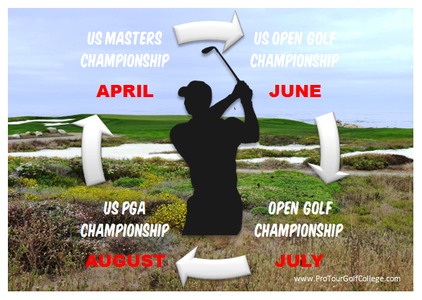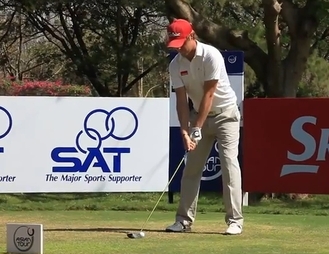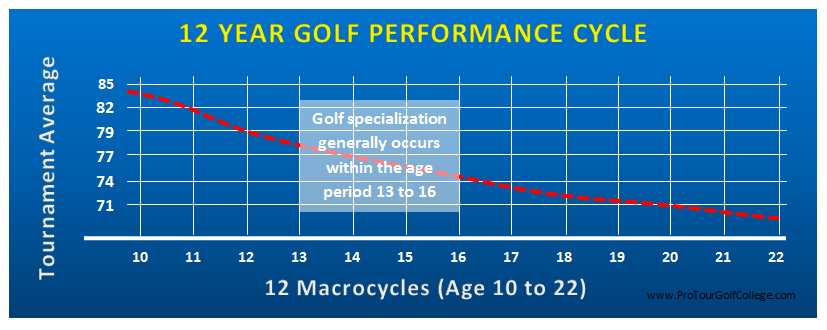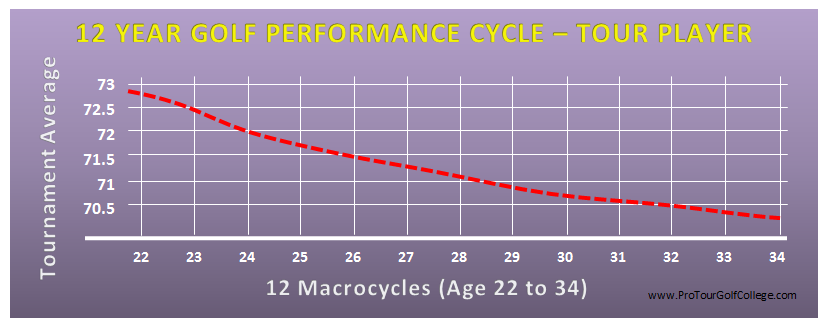"The question that periodization can help you to answer is what type of practice will be done within each cycle (season) so that it enables you to perform to the best of your current ability when important tournaments take place". We are approaching the end of another year of golf and possibly you are starting to think about next year and what you will do to play better than you did this year. It could be that you want to lower your golf score average so you can achieve goals like winning a club championship, or maybe you are at the stage where you are considering going to tour school because you want to play on a professional golf tour. Whatever your goals are for the New Year one thing is for certain, designing a plan for getting there will help, and designing an annual plan will be better than just having a list of outcomes and it will help you to stay focused and on track. But how do you design an annual plan for golf you might be thinking? To begin with let’s look at the two basic components that will be involved in an annual golf training plan. 1. Time 2. Effort (practice and play) Designing an annual plan is an exercise in time and effort management in simple terms. You are going to invest a certain amount of effort in your game via practice and play to perform to your expectations on the golf course. This ratio of effort requires time both in terms of physical effort and also mental effort. So ideally we need to construct a template that takes into consideration the tournaments we wish to play in over the course of a year and also the type of practice that we will do prior to, during and after a tournament. This practice will be driven by your desire to play to the best of your current ability in the tournaments that you rank as most important to you.  I’m sure that you would agree that Tiger Woods would like to play his best at least four times in a season, in April, June, July and August which is when the major championships are held. Yes he wants to play to the best of his ability in every tournament he enters, but these four tournaments are the most important ones for him. What would your most important tournaments be, these are the ones that you would like to place well in, or indeed win? When we design a plan, like any plan it has elements that help you to determine where you are in the process, and tools to help you measure, monitor and adjust as you need to. No golf plan is set in stone, it needs to be flexible and change, and is a true reflection of golf performance that ebbs and flows, that has high points and low points.  At Pro Tour Golf College we use a simple acronym P.L.A.N to help design and manage the change process within the annual plan. P = PERIODIZATION: Periodization is an organized and efficient planning system for your golf practice effort and your tournament play which encompasses a progressive cycling of several characteristics within your golf training program during specific periods in the golf season. It is a method for regulating your golf stroke and target training to peak at a specified period within your golf season. The real worth of a periodized approach to golf development is to plan when you introduce new skills into your practice, as well as to continue to develop existing golf skills in your game as you progress through your annual plan (which is also called a macrocycle) and to develop those skills so that you reach the stage of automaticity with them at a specific time within the plan. Long-Term Golfer Development A junior golfer of 10 years of age will likely go through 10 to 12 Macrocycles before they turn professional. Within these ten to 12 cycles many tournaments will be played, many skills will be learned, and lots of golf balls will be hit. Look at the following example of what a long term view of a junior golfers score development might look like. This is 12 cycles from the age of 10 years to 22 years. The question that periodization can help you to answer is what type of practice will be done within each cycle (season) so that it enables you to perform to the best of your current ability when important tournaments take place. Specialization might occur for a junior golfer around the age of 13 to 16 years (down from 16 to 19 years last century) and this is where a golfer decides that the sport of golf is what they truly want to excel at. Before this period they are usually just competing in tournaments, practicing modestly and enjoying the game. However when they reach the specialization stage (where they make the decision that this is going to be their career) it becomes a lot more serious. And by serious we mean that the work load increases greatly and expectations of how they perform in tournaments becomes more of a central focus. When you design a long term periodized plan for improvement you can manage your expectations more easily, which just happens to be one of the biggest challenges you constantly face as you continue to improve. The chart above describes what a performance curve might look like over an extended time period for a junior golfer through to senior level. This chart could just as easily be for a rookie tour player (below) who is looking at a long term view of his annual performance targets to help him/her to stay focused and motivated towards continuous improvement. Can you see that this can performance curve can adjust as you develop and improve, and that the actual curve in real terms would be a lot more erratic within each annual cycle? This is where the true value of an annual plan comes into its own. You can design your plan around your tournaments and work out the amount of golf shots (volume) as well as the level of intensity, and you can also determine the types of golf shots you want to improve to lower your scores so you can achieve your tournament goals. So when we look at a macrocycle, the tournaments you play in will obviously fall within the 52 weeks of the calendar year. When we design the first stage of the periodized plan it will look something like the one below. GOLF PLAN AND DESIGN STAGE 1 - OBJECTIVES, TOURNAMENT DATES AND LOCATIONSYou can see that at the top of the plan we list the following Six Performance Objective Categories:
 In the example above I’ve identified the state tournaments that John Anderson will play in and also the tournaments that he’d like to peak in (highlighted in yellow), which is to say the tournaments that he wants to play his best in. You could have a combination of state, national and international tournaments that you wish to play in and the beauty of a periodized plan is that you can see your season on one page, and from this vantage point it is a lot easier to decide how you will practice your golf skills to improve your performances on the golf course. Next week we'll go to stage two of designing your annual golf success plan and we will be focusing on golf training phases within the season which is where the periodization starts to help you manage the practice work load and intensity in and around the tournaments you have chosen to play in. Lawrie Montague and David Milne - Pro Tour Golf College Your Success On Tour is Our Business
Swede
24/12/2013 07:36:11 am
Merry Christmas to all of you 27/12/2013 04:00:55 am
Thanks so much and we wish you a happy New Year and successful 2014 golf season and really appreciate your feedback throughout 2013. Comments are closed.
|
Archives
June 2019
|
Proudly Supported By
Copyright © 2011 - 2018 Pro Tour Golf College
Website Managed By Golf Performance Media
All Rights Reserved
Website Managed By Golf Performance Media
All Rights Reserved







 RSS Feed
RSS Feed



